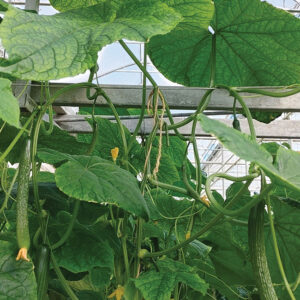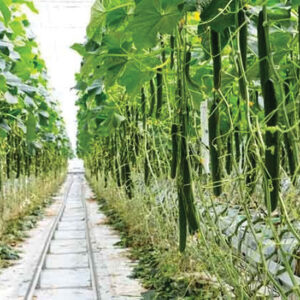
Features
Crops
Managing greenhouse crops in winter
Part two: Cucumbers
December 8, 2023 By Dr. Mohyuddin Mirza
 An example of a crop where plants reached wire very fast, dark green big leaves bending downward, thick stems, and weak flowers. Bending leaves is an indication of low Moisture Deficit, high relative humidity and cooler temperature. This is an example of a very vegetative plant and not much fruit production. Night temperature was going close to 16-17°C.
Photos: Mohyuddin Mirza
An example of a crop where plants reached wire very fast, dark green big leaves bending downward, thick stems, and weak flowers. Bending leaves is an indication of low Moisture Deficit, high relative humidity and cooler temperature. This is an example of a very vegetative plant and not much fruit production. Night temperature was going close to 16-17°C.
Photos: Mohyuddin Mirza Cucumber is a fast-growing, high-light crop requiring a Daily Light Integral (DLI) of 25 to 30 moles/m2/day. The natural light in December is the lowest and daily photoperiod could be as low as eight hours. Some growers have adopted two-crops systems that uses natural sunlight from February to November, finish the crop, clean and sanitize the greenhouse and bring in three-week-old seedlings in late January or early February. The second system is plant seedlings in late October and take the crop through winter using supplemental lights. Other growers use three, or even four, crops per year.
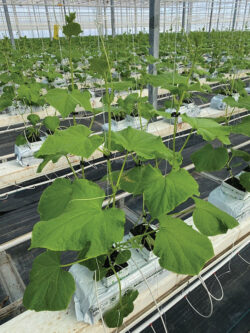
A well balanced cucumber crop. Thin stems, good internodal distance and strong tendrils.
The biggest challenge for winter production is the limited light levels, even with supplemental lights. When light levels are limited, other plant environments must be optimized and regulated to meet the minimum threshold for active plant growth. Cucumber needs about 300 to 400 joules/cm2 threshold for a reasonable active growth.
Understanding how light is measured, what are thresholds for cucumber growth and how to link light levels with other environment inputs like irrigation, temperature, and relative humidity are key factors for effective management. Light also affects plant spacing.
Production cycle – December to March
Plant Focus
- Target for a transplant 25- to 30-days old. Most of the growers obtain seedlings from professional propagators where supplemental light is used. Plants generally have four to six sets of leaves.
- Focus is vegetative to build a strong plant. Let the plant establish in the grow bags in a balanced manner. Plants can grow fast to reach the wire with thin stems and weak leaves.
- Target for rapid development of the stem fruit so as not to delay the development of top growth.
- This is very important. The pictures on the previous page show what can happen if a plant becomes too vegetative.
- Avoid setting fruit on every node. Some growers set fruit at fith or sixth node and then at alternate nodes. High-wire growers and lighted crops set fruit at every node. Plants have mechanisms to tell you if they are not happy by aborting fruits (see photo).
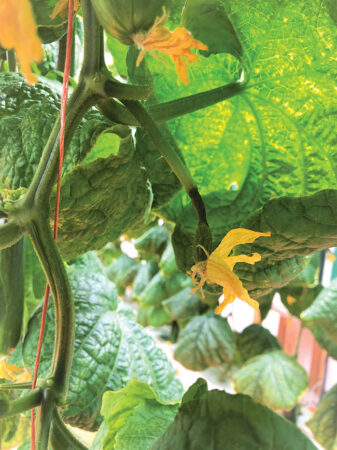
Aborted fruit on a very vegetative plant.
Average 24 hours air temperature minimum 21.5°C dark days, maximum 23.5°C sunny days. Day temperatures are based on light and pipe temperatures and are reduced quickly with increasing light. Recommended pipe temperatures are 50°C during dark days, 40°C n bright days and maximum pipe temperature 75°C.
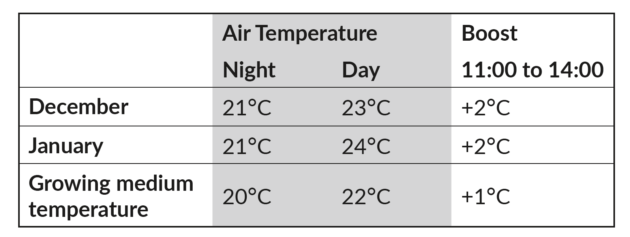
Target temperatures after the first fruit set on the stem
Day average 23°C, night average 20°C, 24 hours average 21 to 21.5°C +1°C increase on light days. Ventilation 1°C higher than the heating set point in dark weather and 2°C higher than the heating set point based on light (bright weather).
CO2 target
800 ppm from one hour after sunrise to one hour before sunset or before supplemental lights are turned off. Avoid flue gas generated CO2 above 1000 ppm. In winter crops be alert to the possibility that flue gas CO2 may contain pollutants which can damage the crop.
Target irrigation/feed
Managing irrigation/feed is very important for winter crops. Unlimited water and nutrients can make the plants vegetative. Using higher Electrical Conductivity (EC) values will help to keep the plants compact and balanced for vegetative and generative growth.
- EC feed 3.0 and an EC of leach the same around 3.0 mS. Use potassium sulfate to increase the EC. Also make sure trace elements are in the optimum range. Iron deficiency in young leaves can occur due to pH going over 6.4 and also inadequate levels of iron and manganese. It is suggested to use four ppm of iron and one ppm of manganese in January and early February.
- Close attention to pH is required in early winter crops because when the plant is establishing and producing roots the pH goes on the alkaline side and iron deficiency can occur as is evident in the picture above, right. If not corrected, the fruit abortion can occur (above, left). Feed pH should be around 5.5 to 6.0. Leach pH should be monitored constantly and adjustments made.
- Quantity of water depends on radiation and heating. Rule of thumb is three times solar radiation until active vent period. For example, if light levels reach 500 joules/cm2, then multiply by three = 1500 ml/m2/day
- Avoid the use of ammonium-based fertilizers during this crop season. Pay attention to nitrogen to potassium ratio (1:2), calcium to magnesium ratio of 3:1, iron to magnesium ratio of 3:1.
Target Vapour Pressure Deficit (VPD) or Moisture Deficit (MD)
It is important to maintain an active climate in the greenhouse, especially in January and February. VPD is a calculation based on temperature and relative humidity and provides a good measurement if plants are transpiring actively. Target a VPD of between three to seven grams/m3 of air. Millibars and Kilopascals (Kpa) are other terms for this. So, know how this calculation is reported by your computer.
- Try to keep the VPD not less than 3.5 grams/m3 especially when plants are one- to 1.5-metres high.
- Stimulate the plant with pipe heat and small ventilation crack 0.5 cm when VPD is going below 3.0 grams/m3. Aggressive ventilation may be required to avoid condensation on the plants.
Light Levels
- Intensity can range from 50 to 150 joules/cm2 in the early part of planting.
- Adjustments should be done when it is cloudy for longer periods by reducing the day temperature.
Target leaf and fruit number
For cucumbers grown using an “umbrella” system, where plants are grown to the wire, about 1.5 metres, and then fruit develops on laterals, target 20 leaves up to the wire. For high-wire cucumbers, there is no rule on number of leaves because plants are grown on a single stem. Try to maintain a ratio of two to three leaves/fruit. For high-wire cucumbers, the stem is taken to around four metres and then it is lowered.
More leaves are removed compared to umbrella system to get light into the canopy. In my opinion cucumber plants have better vegetative and generative balance in this high wire training system.
CORRECTION NOTICE
In the first article of this series entitled ‘Managing winter greenhouse vegetable crops. Part one: Tomatoes,’published in the November 2023 issue of Greenhouse Canada, an error appeared under Target CO2. The target should be: “between 800 to 1000 parts per million of CO2.” We apologize for any confusion this may have caused.
drmirzaconsultants@gmail.com
Print this page
